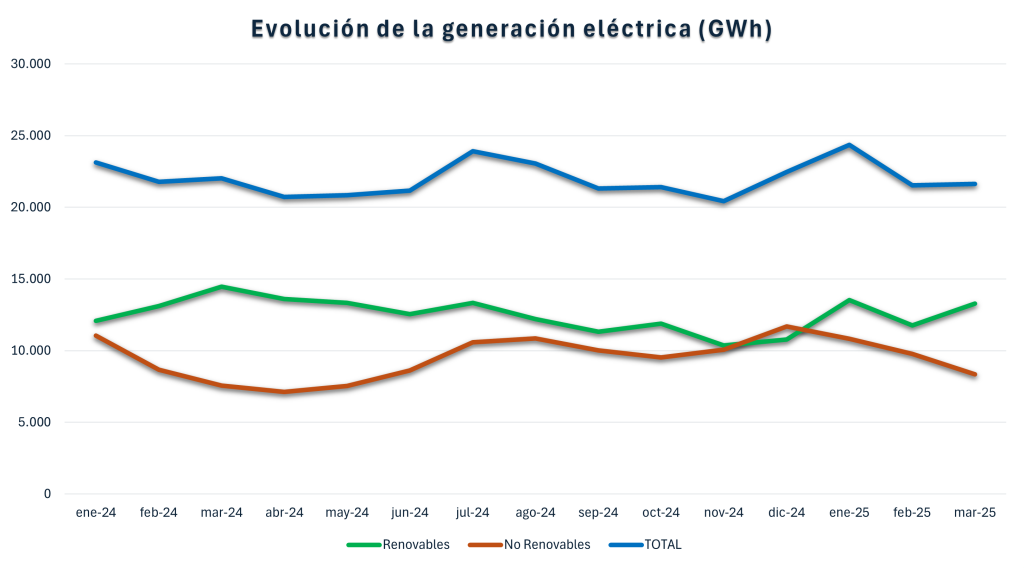-
Hydropower’s contribution to the energy mix falls from 21.5% in March 2024 to 18.3% in March 2025 despite the rain.
-
Storing water now is like saving “electrons in the form of H₂O.”
-
Saving hydropower for July and August can help increase the share of renewables during these months, when other sources falter.
March 28, 2025
Elis Regina probably never imagined that her song about the águas de março (“waters of March”) could be the perfect anthem to illustrate Spain’s energy reality in 2025. While in Brazil the rains close out the summer (são as águas de março fechando o verão), in Spain they’ve decided to give an early spring a cold shower of reality.
These torrential March 2025 rains in Spain seemed like the perfect setting for an energy role reversal: less sun, more water. Logic suggested that photovoltaic output would drop due to lack of sunlight and hydro would spike thanks to full reservoirs. But data from Red Eléctrica dismantles this narrative. Solar photovoltaic barely reduced its share in the mix (from 13.9% in March 2024 to 12.4% this March), while hydro didn’t come to the system’s rescue—in fact, its contribution fell from 21.5% last March to 18.3% in March 2025. Total electricity generation so far this month has even decreased 1.8% compared to the same month in 2024 (from 22,032.21 GWh to 21,634.67 GWh). How is that possible? The answer isn’t in the cloudy sky, but in a more complex equation with more variables than just weather: demand, price, and storage strategy.
One key lies in distinguishing between run-of-river hydro (dependent on immediate river flow, unpredictable and short-lived) and reservoir hydro (stored water, manageable like a strategic asset). And that’s where the magic happens. These March waters aren’t being used—they’re being stored as an energy treasure. Why? Simple: July looms. In the middle of summer, electricity demand spikes, heatwaves strain the grid, and electricity prices reach historic highs. Storing water now is like saving “electrons in the form of H₂O” to use when they’re needed—and, let’s not fool ourselves, when prices and demand rise. Power lies not in the falling water, but in the water we save. And water isn’t generated—it’s managed.
One of the positives of hydro storage is its ability to support renewable generation in July, a critical month when other renewable sources falter.

Source: Red Eléctrica and own elaboration
Although it may seem counterintuitive, solar—despite the heat—operates with fewer effective sunlight hours, and wind, traditionally weak in July, doesn’t fill the gap. However, the water stored in reservoirs allows hydro to be activated just when it’s most needed, avoiding reliance on fossil fuels or non-renewable technologies. This ability not only reaffirms hydro as a storage technology, but highlights the need for a diversified and flexible renewable mix. Thanks to foresight in March, July could become a month with a stronger renewable share.
Industry could be one of the big beneficiaries of this framework in its race toward decarbonization. The industrial sector cannot afford the ups and downs of an electricity system exposed to weather whims. Its competitiveness demands predictable prices, stable supply, and a robust energy mix combining the controllability of hydro (especially reservoirs), the intermittency of solar, the variability of wind, and—crucially—storage. This diversification is vital to prevent climate changes from turning into extreme volatility and, ultimately, production shutdowns.
The Spanish águas de março don’t close the summer, like in Brazil—they prepare for it. This rainy March was a rehearsal for what’s coming: a world where energy is planned ahead, not based on weather forecasts. Spain has the resources—sun, water, wind—but the challenge lies in managing them with a chess master’s strategy.
